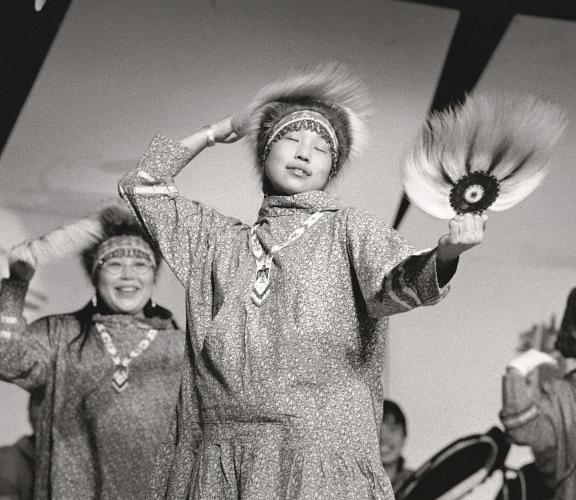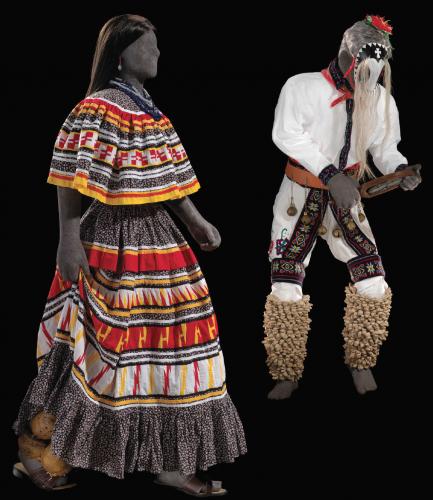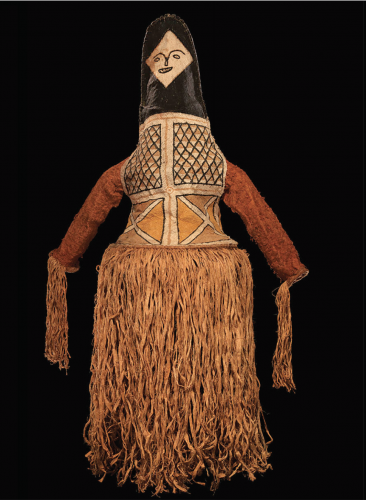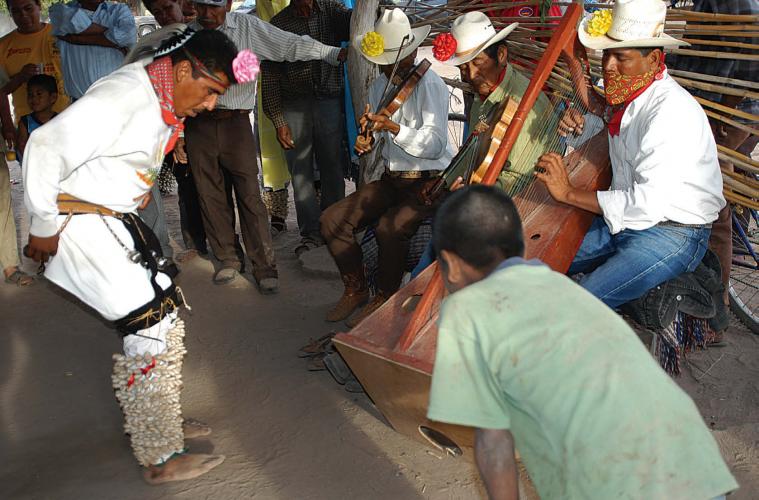Consistent across time and cultures is the use of the body to communicate and express – to tell stories, participate in the cycles of nature, mourn, pray and celebrate. Throughout the Americas, music and dance have always been an essential part of the spiritual, cultural and social lives of Native peoples. The ancient Maya maize god was a god of dance. And, to this day, unique forms of ritual, ceremonial and social dancing maintain a vital place in contemporary community life. Everywhere dance is found in Native America, it is accompanied by distinctive Native musical styles. Rich music and dance traditions create deep ties that bind American Indian communities to all living things – to the earth, to the spiritual world and to each other.
Music and dance also bind communities to the past when people have deep ancestral claims, as they often do, to their dances. Even where songs and dances are borrowed from neighboring groups, as they sometimes are, they play a central role in people’s lives. And so too do ritual dances that combine Christian and indigenous knowledge. Indigenous ceremonial dances are dynamic events that allow Native peoples to maintain old ways and introduce new ones while expressing and celebrating their strongly felt tribal, village, clan, society and individual identities.
Often the time of a performance, direction of a dance, number of dance phrases, musical instruments, words of songs and ceremonial dress are highly symbolic and are tied to a community’s cosmology and most deeply held beliefs. For well over 50 years in the United States and Canada – and for centuries in Latin America – church and “civilization” regulations discouraged and even outlawed many indigenous dances.
Deemed dangerous, offensive and prohibited in the late 19th century, the Ghost Dance and Sun Dance are perhaps the best known of these ceremonies. But many other traditional American Indian ways involving dance were discouraged or disallowed by Indian Agents and missionaries in Native communities across the Americas. Deeming such ways an impediment to conversion and assimilation, Canada, for example, also prohibited Native societies from performing their ceremonies. Most notable was the potlatch that, on the Northwest Coast, involved gift giving and impressive oratory, as well as dramatic dances.
Not until the second half of the 20th century were such prohibitions fully reversed. Today, in the second decade of the 21st century, many Native communities continue to preserve their traditions involving dance. Some of these traditions had gone underground for decades. Others, owing to particular historical contingencies, have only recently been revived by tribal members. And still others continued unperturbed throughout the 20th century.
Today these social, ceremonial and spiritual dances, involving whole communities, are considered essential not only in affirming Native cultural autonomy, but, more importantly, in maintaining spiritual, physical and emotional well-being. The harmony of body and mind comes about in continuous movement set to the rhythm of turtle-shell, gourd and deer-hoof rattles; conch shell trumpets; rawhide drums; bird-bone whistles; cane, wood and ceramic fl utes; wood or bone rasps; copper bells; many other musical instruments and an amazing repertoire of vocal music. A powerful impulse, dance is a universal form of expression that remains deeply meaningful in Native America — and integral to Native ceremonial life.
Opening in October at the Museum’s George Gustav Heye Center in New York, a new fi ve-year exhibit called Circle of Dance will interpret these traditions. Presented in the Diker Pavilion for Native Arts and Culture, a 6,000-square-foot exhibition and performance space, it will represent each of the 10 dances through the display of a manikin in full regalia and a distinctive dance pose. An accompanying media piece will complement and enhance the manikin displays. Presenting the range of dances featured in the exhibition, this high-defi nition video will capture the variety of the different Native dance movement vocabularies, and the music that is integral to their performance. Additionally, the media piece will underscore the vital connection between dance and place.
Exhibition label copy is drawn from essays, written for the exhibition’s accompanying website, by contributors with a deep appreciation of the social, cultural and ritual signifi - cance of a particular dance and who illuminate that signifi cance. As is evident from their essays, all of the dances share fundamental underlying meanings in which peoples’ close communion with their ancestors and the natural (including animal) and spiritual worlds fi gure prominently. Above all, each of these dances embodies an awareness of a greater cosmic order and often the importance of reciprocal relationships in maintaining that order. In other words, life-sustaining concepts are embedded in these dances.
The Ten Exhibition Dances
Yoreme Pajko’ora Dance
Yoreme ceremonial performers from the southern Sonora and northern Sinaloa states in Mexico, known as pajko’ora, appear at religious ceremonies or fiestas throughout the year. They are important during the dramatization of the Passion of Christ during the Easter season. In the past, pajko’ora danced to seek permission and forgiveness from animal spirits Yoreme were going to hunt. The dance was devoted to the spirit of the animals that would give up their lives for the continuation of human life. Over the last 300 years, this hunting ritual has evolved, as Felipe Molina (Yoeme) writes, into an elaborate Yoreme Christian devotional vigil. The presence of pajko’ora during the Easter season is linked to the sacred ceremonies conducted at a close-by altar upon which are statues of Jesus and the Blessed Mother Mary.
Pajko’ora wear strings of pebble-filled, dried giant silk moth-cocoon rattles covering their legs from their ankles to knees. When dancing to the accompaniment of a harpist and fiddler, the pajko’ora assumes a slouched position, with his head slightly down and his arms dangling. He wears a small wooden mask at the back of his head. When dancing to the accompaniment of a drum and fl ute, the pajko’ora wears the mask over his face and shakes a wooden rattle with metal disks in his right hand, beating it at times against his left palm.
The pajko’ora dance barefoot in a ramada and often in place. Starting slowly, their bodies are relaxed and knees slightly bent. Their steps are grounded and emphasize their connection with the earth. The sounds of their leg rattles resemble the sounds of rattlesnakes. Each pajko’ora dances alone at first (there are usually three in a group), and then dance with the Deer Dancer. The Deer Dancer, like them, is devoted to Jesus and the Blessed Virgin.
While incorporating strong elements of Christian spirituality, the dance of the Yoreme pajko’ora and Deer Dancer also affirms traditional Yoreme spiritual beliefs, in a deeply complex religious drama that has its combined roots in Spanish Jesuit Catholicism and Yoreme metaphysics.
Mapuche Mutrum Purun
In rural areas in central and southern Chile, the Mapuche Mutrum purun is performed to welcome a guest community to a Ngillatun (Thanksgiving and pleading ceremony) held every two to four years. The Mutrum purun is led by a machi (religious leader) who is the mediator between the Mapuche people and the land above, the Wenu mapu (the blue space above where good deities and ancestors live). As some men play a pifullka (ritual fl ute), the machi beats his or her kultrung (drum), one of the most ritually important objects among Mapuche. The symbolic painting on a kultrung represents the Mapuche cosmos and desired equilibrium of the Mapuche world. The drum is always held facing the East because the beneficial deities live in that space.
As Maria Catrileo (Mapuche) explains, the Mutrum purun is a lively dance involving leaps and jumps. It takes place around an altar at a ceremonial ground with the host and guest groups facing each other. Dancing at fi rst in jumping steps, they mix together. Then the men and women of both groups dance separately, fi rst leaping and then moving in slow steps, hitting the ground twice with each foot as they turn towards the right and then towards the left. The visitors dance backwards and the hosts dance forward and then vice versa till they all reach the altar where they face each other behind ritual jugs full of muday (native beverage) placed at the altar.
Rooted in respect for the Ngunechen (a deity encompassing the spiritual family that governs and controls nature and life), the Mapuche Mutrum purun takes the dancers to a spiritual level and readies them for the Ngillatun.
Hopi Butterfly Dance
This social ceremonial dance for young people takes place each year in the late summer. Up to a hundred or more young men and women, and boys and girls, dance in pairs in open village plazas on their reservation in northern Arizona, accompanied by a chorus of singers comprised of their male relatives. Holding their upper bodies upright, the dancers appear in the plaza in two lines facing each other. The girls, with eyes cast down, hold juniper sprigs. The boys hold rattles. Both dance by lifting their knees in springing steps, occasionally turning as they snake through the plaza, and occasionally pausing to dance in place.
As Gloria Lomahalftewa (Hopi) writes, the village men provide the dance’s prayer songs, which often evoke the natural world and thank the Creator for the Hopi way of life. As with the ancient Maya, Hopi life is based on corn agriculture and the need for summer rains that nurture corn and thus Hopi people. Traditionally, Hopi depended upon rain for their survival. They also depend upon each other to carry out their communal and ceremonial obligations, including ceremonial dances. In the Hopi Butterfly Dance, Hopi youths participate in prayers and thanks for rain, nature’s gift, and a Hopi lifeway centered since their Emergence on desert farming.
Seminole Stomp Dance
The Seminole Green Corn Ceremony, the Seminole’s primary traditional religious and social gathering, always coincides with the ripening of corn. The ceremony takes place annually, in May or June, at the tribe’s ceremonial grounds, undisclosed locations in South Florida where religious rituals are held. Stomp dancing, an integral part of the Green Corn Ceremony, takes place each evening during the gathering. Men and women dance in single file, in a continuous line of movement behind a spiritual leader, singing call-and-response songs and keeping time with a coconut rattle. The dancers form a spiral, which circles counterclockwise around a central fire. With their knees slightly bent and bodies relaxed and slightly inclined forward, the men and women circle the fire in close formation with slow stomping steps of three or four inches. The men sing out the responses, while the women provide the rhythm with the sound of their leg rattles. And as Willie Johns (Seminole) writes, the stomp dancers’ increasing energy creates a wind, forcing the smoke upward. The swirling smoke carries the song’s message to the Creator, who blesses the dance, a fundamental component of the Seminole’s annual rite of thanksgiving.
Tlingit Ku.eex Entrance Dance
Recognition and remembrance of a clan’s relationship with the ancestral being from whom it descends, and from whom it has received certain rights, is a basic protocol at Tlingit ku.eex including, importantly, the dances that are a vital part of them. Among the Tlingit along the Pacific Northwest Coast, ku.eex are hosted by clan leaders to memorialize a clan member’s death approximately one year after the person’s death.
At the beginning of the ku.eex, the hosts – dancers, drummers and singers – make their entrance performing an Entrance Song. The dancers appear one at a time, each wearing a robe with his or her crest. Crests are animal emblems, or totems, that identify clan members and honor ancestral encounters in the history of the clan. With their elbows bent outward to spread open their robes, the dancers circle the dance floor with shoulders, chests and hips turning to the right and then to the left, and occasionally strike positions facing towards or away from the audience. The men dance more robustly, frequently crouching and turning their heads from side to side. Women move more gracefully. And as Maria Shaa Tlaa Williams (Tlingit) writes, when all the dancers have entered the performance space and the entrance song ends, the dancers line up and turn their backs to the audience, to display the crests that explain their existence in the world.
Cubeo Oyne Dance
The Cubeo mourning, or weeping, ceremony was once performed regularly along the Uaupes River in Columbia and Brazil but was suppressed by missionaries in the 1940s. It occurred up to a year after a person’s death and lasted several days. Men wear knee-length bark-cloth outfits painted in scales for fish, in wings for birds and insects, and in other animal designs; they imitate animal spirit beings from the Cubeo world. As Janet Chernela writes, the range of animal spirits represented is large, but the principle spirit beings are Butterflies, Dung Beetles, Jaguars, Aracu (fish) and Sloth. These and other animal spirits include both beneficial and malevolent demons that are otherwise only visible to shamans.
They enter into the village of the deceased, upon the weepers’ (women’s) domain, and dance and perform among the mourners. The dancers, sometimes in pairs, perform distinctive gestures of the animals they represent and accompany their movements with songs imitating animal sounds while beating the ground rhythmically with dance battalions. The dancers/animal spirit beings, the primordial mourners, transform the collective mood from somber grief to unrestrained play.
Powwows: Yakama Girl’s Fancy Shawl Dance
Powwows have become one of the most powerful expressions of cultural identity in the Indian world today. With roots in Plains Indian ritual and ceremonial dances, they are public and intertribal events that draw Indian people together, in the United States and Canada.
Powwow dancing emerged by the 1930s in response to government efforts to prohibit ceremonial dances among Plains Indians. Powwows spread across and beyond the Plains in the 20th century. One of the favorite expressions of powwow dance for young Yakama girls is the Fancy Shawl Dance. The Yakama sponsor several powwows a year, the largest being The Yakama Nation Commemoration of 1855 Treaty Days Powwow that takes place in June on the Yakama Nation reservation in southwestern Washington State. As Zelda Winnier (Yakama) explains, this dance is similar to a Yakama social dance called the Butterfly Dance, in which the girls use the Butterfly Dance song to imitate the butterflies departing from their cocoon. Both their Fancy Shawl and the Butterfly songs are fast and lively. The girls twirl around the indoor or outdoor arena, each demonstrating her own intricate and high-stepping footwork. With every beat of the drum, one foot taps the ground. On the last beat of the song, the dancers land on both feet. In the Yakama Fancy Shawl Dance, the girls wear a colorful fringed shawl over their traditional t’piip, or wingdress. In the Fancy Shawl Dance, as in the social circle of the Yakama People, young girls interpret butterflies “fluttering in meadows of flowers,” expressing themselves and their culture through movement, imagination and a connection with spirit.
Powwows : Men’s Northern Traditional Dance
Large contest powwows, with dance categories for boys, girls, men and women, emerged after World War II and are performed in small reservation communities and urban centers. Men’s Northern Traditional dancing evolved out of Plains warrior society dances. At a powwow, each Northern Traditional Dancer tells a story through a sequence of movements. Some dancers imitate the movements of animals. As Tara Browner (Choctaw) writes, many tribes believe that animals gave the gift of dance to humans. While imitating animals facilitates an essential connection with nature, other Northern Traditional Dancers mimic demonstrations of bravery (tracking an enemy or hunting) with their particular combination of steps and upper-body motions. While often crouched, each dancer has his own way of moving and steps forward with a quietly powerful presence. Each of his movements tells part of his story. Communicating through movement, the footwork and gestures are always attuned to the tempo of the song and to the drum’s heartbeat, that is, to “the sound of the vibrating earth.”
Yup’ik Quyana (Thank-You) Song Dance
According to Chuna McIntyre (Yup’ik), Yup’ik dancers from western Alaska dance to please their ancestors during their mid-winter ceremonies. Each dance has its own yuarun (songs) sung by men to drum beats. The verses and chorus of the songs contain vocables as well as words often descriptive of the actions or events that the dance depicts. Men usually kneel in front while women stand behind them, feet flat, with their knees bent and upper bodies swaying. Their extended arms elongate their movements. Both male and female dancers use mainly their arms and upper body movements to tell their stories. Hand-held caribou hair fans, said by McIntyre to represent the human spirit itself, accentuate the fluid movements of the women’s arms, while men dance with feathered finger fans. Though firmly grounded, the dance is graceful.
Some dance stories and movements are inherited, others are newly composed. The Quyana (Thank-You) Song Dance, featured in Circle of Dance, is ultimately about growing up. The song describes a dancer’s clothing. As McIntyre writes, “As we grow up, we receive more responsibilities. The ornaments Yup’ik dancers wear are the physical manifestations of our responsibilities. So the song’s message is that we Yup’ik ought to be thankful for the responsibilities bestowed upon us.”
Quechua Danza de Tijeras (Scissor Dance)
Designated in 2010 by UNESCO as an Intangible Cultural Heritage of Humanity, the danza de tijeras (scissor dance) is performed in Quechua communities such as Huancavelica, Ayacucho and Andahuaylas in the south-central Andean highlands, and now in urban centers. The dance is performed by usually male, but sometimes female, dancers who wear multicolored outfits embroidered with gold fringe, multicolored sequins and small mirrors. As Peruvian historian Fernando Flores- Zuniga writes, the dancers form teams with violinists and harpists, and their dance involves step-dancing and acrobatics, dynamic gymnastic movements requiring great dexterity and physical ability. Powerfully athletic, they dance with explosive power either standing or on the ground with hands supporting the dancer as much as the feet. Trained from a very young age, the dancers hold two scissor blades in their right hand, which they strike to the rhythm of the music as they dance.
The origins of the danza de tijeras are obscure, but the dance today fuses Christian tenets with indigenous beliefs centered on the spiritual importance of the natural world and, in particular, the Andean mountains. The dancers are said to gain their endurance from the wamanis, or spirits of the mountains. The danza de tijeras is performed at festivals timed to accord with the Andean Highland agricultural calendar and also with Catholic feast days. Though now an integral part of village Catholic feast-day observances, dancers dressed in their regalia – considered the god-children of the wamanis – are not allowed in churches.
Despite the many historical factors that have interfered with its practice, dance remains a vibrant, meaningful and diverse form of cultural expression in many Native communities throughout the Americas. Reflecting different experiences and ways of being in the world, and comprising a vast range of dance styles and movement vocabularies, Native dances draw on deeply rooted cultural traditions. Ultimately, they remind people of their connection to all living things and unite people with the world around them. Whether invoking clouds, rain and growth, spirits of the ancestors or hunter’s prey, or, perhaps most remarkably, fusing intercultural histories, Native dances, often deeply integral to ritual performances, express core beliefs about the world and the most fundamental relationships upon which life depends.





